

Meet the Romans with Mary Beard (2of3): Street Life. A day in the life of a Roman soldier - Robert Garland. 7 surprising facts about Roman women. 1) Breast is best?

Roman doctors thought so, but mothers weren’t convinced Wealthy Roman women did not usually breastfeed their own children. Instead, they handed them over to a wet-nurse – usually a slave or hired freedwoman – who was contracted to provide this service. Soranus, influential author of a second-century work on gynaecology, prescribed that a wet-nurse’s milk might be preferable in the days after the birth, on the grounds that the mother could become too exhausted to feed. He did not approve of feeding on demand, and recommended that solids such as bread soaked in wine should be introduced at six months.
Meet a Real Modern Gladiator. A History of Ancient Rome. Horrible Histories - Romans Come dine with me. Pompeii: The Last Day (BBC) History - Work and Play in Everyday Pompeii Gallery. A Day in Pompeii. BBC Two - Pompeii: The Mystery of the People Frozen in Time - Learning Zone - Clips. Four sisters in Ancient Rome - Ray Laurence. A glimpse of teenage life in ancient Rome - Ray Laurence. ROME ANNO DOMINI C vel 100. History - Ancient History in depth: Christianity and the Roman Empire. Roman Daily Life (Article) Ancient Roman Women: A Look at Their Lives - women's rights, Rome, citizenship, Cornelia, Oppian Laws, divorce, aristocracy.
Any historical investigation into the lives of ancient women involves individual interpretation and much speculation.
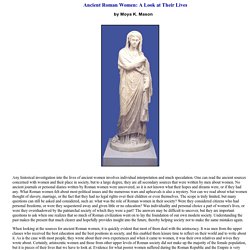
One can read the ancient sources concerned with women and their place in society, but to a large degree, they are all secondary sources that were written by men about women. No ancient journals or personal diaries written by Roman women were uncovered, so it is not known what their hopes and dreams were, or if they had any. What Roman women felt about most political issues and the numerous wars and upheavals is also a mystery. Nor can we read about what women thought of slavery, marriage, or the fact that they had no legal rights over their children or even themselves. The scope is truly limited, but many questions can still be asked and considered, such as: what was the role of Roman women in their society? When looking at the sources for ancient Roman women, it is quickly evident that most of them deal with the aristocracy. Related Papers Notes 1 Jo-Ann Shelton. 3 Ibid. Women In Ancient Rome. Women in ancient Rome. The educated and well-traveled Vibia Sabina (ca. 136 AD) was a grand-niece of the emperor Trajan and became the wife of his successor Hadrian; unlike some empresses, she played little role in court politics and remained independent in private life, having no children and seeking emotional gratification in love affairs[1] As is the case with male members of society, elite women and their politically significant deeds eclipse those of lower status in the historical record.
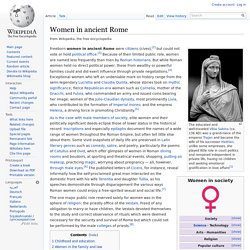
Inscriptions and especially epitaphs document the names of a wide range of women throughout the Roman Empire, but often tell little else about them. Childhood and education[edit] Roman girls playing a game. BBC: Gladiators: Heroes of the Roman Amphitheatre. BBC: Resisting Slavery in Ancient Rome. BBC: Social Pecking Order in the Roman World. Slavery in ancient Rome. Roman mosaic from Dougga, Tunisia (2nd century CE): the two slaves carrying wine jars wear typical slave clothing and an amulet against the evil eye on a necklace; the slave boy to the left carries water and towels, and the one on the right a bough and a basket of flowers[1] Slavery in ancient Rome played an important role in society and the economy.
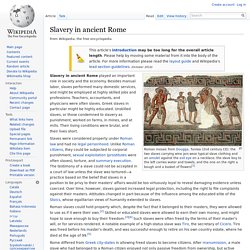
Besides manual labor, slaves performed many domestic services, and might be employed at highly skilled jobs and professions. Teachers, accountants, and physicians were often slaves. Greek slaves in particular might be highly educated. Unskilled slaves, or those condemned to slavery as punishment, worked on farms, in mines, and at mills. Rome differed from Greek city-states in allowing freed slaves to become citizens. Vernae (singular verna) were slaves born within a household (familia) or on a family farm or agricultural estate (villa). A major source of slaves had been Roman military expansion during the Republic. Origins[edit] Social class in ancient Rome. The toga, shown here on a statue restored with the head of Nerva, was the distinctive garb of Roman male citizens Social class in ancient Rome was hierarchical, but there were multiple and overlapping social hierarchies, and an individual's relative position in one might be higher or lower than in another.[1] The status of freeborn Romans during the Republic was established by: Roman society was patriarchal in the purest sense; the male head of household (paterfamilias) held special legal powers and privileges that gave him jurisdiction (patria potestas) over all the members of his familia, a more encompassing term than its modern derivative "family" that included adult sons, his wife (but only in Rome's earlier history, when marriage cum manu was practiced), married daughters (in the Classical period of Roman history), and various relatives as well as slaves.
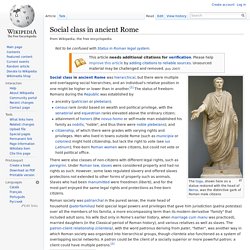
Patricians and plebeians[edit] Originally, all public offices were open only to patricians, and the classes could not intermarry. Life in Roman Times. As with many cultures, a person’s quality of life depended in many ways on their rank within the social structure.
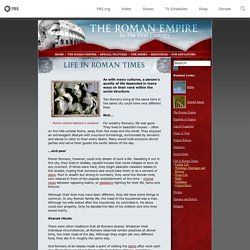
Two Romans living at the same time in the same city could have very different lives. Rich… For wealthy Romans, life was good. The Roman Empire: Social Order. Traditionally, Roman society was extremely rigid.
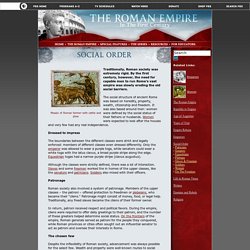
By the first century, however, the need for capable men to run Rome’s vast empire was slowly eroding the old social barriers. Roaming Romans. A glimpse of teenage life in ancient Rome - Ray Laurence. Roman Clothing. Roman clothing owed much to that of ancient Greece, but it had distinct forms of its own.

In all the ancient world, first and foremost clothes needed to be simple. As for possible materials there was only really one. Wool, although to some extent linen was also available. The needles of the day were coarse and unwieldy by modern standards. Hence any stitching or sewing was kept to a minimum. Underwear As undergarments Romans would wear a simply loin cloth knotted on each side. Undergarments are believed to generally have been of linen. The Tunic So a senator could wear a tunic featuring a vertical broad purple stripe down the centre. It is worth mentioning the tunica palmata which was a brightly coloured tunic embroidered with palm leaves and was worn by the triumphator during his triumph, or possibly by other dignitaries at other, very exceptional occasions.